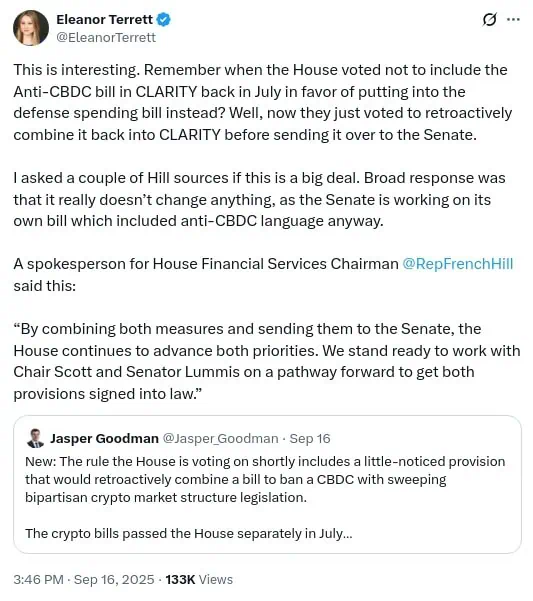
US lawmakers are moving forward in Washington with the unification of two key laws to regulate cryptocurrencies and protect users.
Washington took an important step in regulating cryptocurrencies by approve the unification of the CLARITY and Anti-CBDC laws, seeking to create a clearer and more coherent legal framework for projects and users. This integration not only simplifies legislative work but also reflects a more aligned vision among the different branches of government for managing digital technologies jointly.
What is relevant is that the regulation of cryptocurrencies and the role of digital currencies issued by central banks ceased to be isolated issues and became part of a single national strategy. The approval of this unification in the Chamber, and its pnext discussion in the Senate, shows a rare coincidence in the American financial world: a consensus that transcends political differences to address the future of money, technological innovation, and how institutions will oversee these changes.
Trade crypto today. Bit2Me gives you frictionless access.Eleanor Terrett of Crypto in America recalled how in July the House decided not to include the anti-CBDC bill in CLARITY, instead incorporating it into the defense spending bill. However, a vote has now been taken to retroactively combine it into CLARITY before sending it to the Senate—a decision that, according to sources on Capitol Hill, doesn't change the outlook because the Senate is already working on its own legislation that includes anti-CBDC restrictions.
In short, the unification of both regulatory proposals was approved and marks a significant advance in regulatory consolidation that will allow for greater clarity and consistency in the development of digital money in the United States.
Clarity and Anti-CBDC join forces: a move to balance the digital future
The decision of the House of Representatives of fuse The CLARITY Act, along with the Anti-CBDC bill, wasn't simply a technical maneuver. It represents an institutional strategy to consolidate priorities that, while distinct in origin, converge in purpose.
On the one hand, the CLARITY Act seeks to provide clear rules for the crypto industry, facilitating the operation of businesses and protecting consumers in an environment that has so far been regulatory ambiguous. On the other hand, the Anti-CBDC bill addresses concerns about state control of digital money by proposing explicit limits on the development of a Federal Reserve-issued digital currency for the US dollar.
By uniting the two proposals, Congress is sending a signal of political cohesion. Legislators from both parties have expressed interest in moving toward comprehensive regulations that not only regulate the crypto ecosystem but also establish barriers to digital money models that could upset the balance between financial innovation and government control. This merger allows the Senate to receive a more robust legislative package with bipartisan support and a coherent narrative.
Additionally, the consolidation of these key pieces of legislation will facilitate negotiations in the Senate, where representatives such as Senator Tim Scott and Senator Cynthia Lummis are already working on their own drafts. The combined version from the House of Representatives will serve as a point of comparison, speeding up the deliberation process and increasing the likelihood of final legislation being passed before the end of the fiscal year.
In this scenario, the merger represents a political move that seeks to align institutional interests around a shared vision of the digital financial future.

Cryptocurrencies and CBDCs: Two Sides of the Same Political Coin
The unification of the legislative projects in question reflects an evolution in the political discourse surrounding digital assets. Until recently, crypto regulation and the discussion about CBDCs were addressed as separate issues: one linked to technological innovation and the other to monetary policy. Now, Congress has decided to intertwine them, recognizing that both directly influence the country's financial architecture.
The CLARITY Act, with its emphasis on transparency and operating rules for the crypto world, responds to the need to provide certainty to businesses, investors, and consumers. At the same time, the Anti-CBDC bill expresses an ideological concern: preventing the federal government from exercising greater financial control over citizens through a centralized digital currency. By merging the two, Washington establishes that regulation of the crypto ecosystem is inextricably linked to the stance toward state-run digital money.
The new approach also has international implications. While countries like China are moving forward with their own CBDCs, the United States is opting for a more cautious approach, prioritizing private sector oversight and limiting the state's role in the issuance of digital currency. The legislative integration strengthens this stance and positions the US as a defender of a decentralized and competitive model, in which cryptocurrencies operate under clear rules but without direct government intervention in the creation of digital assets.
Ultimately, the legislative decision redefines the regulatory framework and establishes a clear political narrative: the future of digital money in the US will be shaped by collaboration between private innovation and institutional oversight, rather than state centralization. Beyond the technical details, that message is the one that resonates loudly in the halls of Capitol Hill today.
Toward a new era for digital money in the US
The combination of the CLARITY Act and the Anti-CBDC bill represents a key point for digital finance policy in the United States. It's not just about changing the rules, but about establishing a clear focus: driving innovation in cryptocurrencies without the government taking direct control of digital money.
With bipartisan support and a well-defined institutional vision, Congress has moved toward a law that could shape how the crypto ecosystem is regulated in the coming years. Now, the focus is on the Senate, where it will be decided whether this regulatory unification proposal moves forward or falls by the wayside.
The crypto revolution is underway. Participate with Bit2Me.


